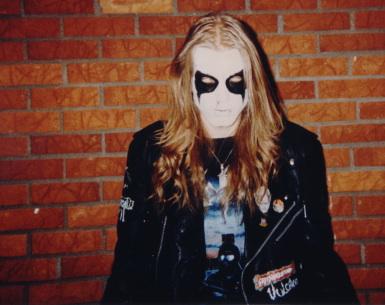
Until the Light takes Us (Movie Review)
Norwegian black metal like most significant rock and roll movements started with a rejection of the values of polite society, From the mid-eighties to the early nineties a slow burning fire in the bellies of Norway’s young musicians gave life to a musical form rooted in Norse mythology; one that took an adversarial stance towards commercialism, traditional song structure and the Christian folkways of Norwegian culture. Donning ghoulish corpse paint and championing the cult of the individual over a world lost to chaos at the hands of demagogues, the pioneers of Black metal ground out a series of bleak, caterwauling manifestos that beckoned those searching for the next extreme musical abyss. With the new doc “Until the Light Takes Us” filmmakers Aaron Aites and Audrey Ewell set out to recount the history of how this groundswell of Scandinavian angst became a conflagration. One that culminated in an epidemic of church burnings, the murder of one of its progenitors at the hand of another and eventually the mainstreaming of the form for a broader audience.
The film constructs a loose history of the genesis of Black Metal using archival footage and interviews with the authors of the early movement. The two players providing the bulk of the insight are Gylve Nagell of DarkThrone and the infamous Varg Vikernes, founder and sole purveyor of Burzum and the convicted murderer of one-time band mate ( from Mayhem), friend and black metal trailblazer Euronymous. The two explain the early spirit of mistrust and alienation that fueled their iconoclastic constructs. Nagell some twenty years in still seems bemused by the same dichotomies that led him to break from death metal form. Varg for his part is less interested in the music than the movement around it. As to his crimes he is unrepentant and holds that he killed preemptively to save his own skin and burned churches to avenge his homeland for the sins of a Christian insurgency some 900 years in the past. Throughout the course of the film it becomes evident that the version of black metal that Vikernes and Gylve hold dear is vanishing. The filmmakers posit that like all things that find success in a broader market the saleable image and a predictable polished product have eradicated the extemporaneous and authentic components of the original black metal design. Gylve doesn’t see himself having any responsibility for the change but Varg acknowledges that his revolutionary intent was hijacked by misunderstanding teens out for kicks rather than making statements. Later in the film we meet Frost of the band Satyricon as he is recruited by artist Bjarne Melgaard to do a performance piece at the opening Melgaard's installation on black metal as a cultural phenomenon. This segment provides striking contrast between today’s sexy, up-marketed, black metal image and the gut level expressionism of the early days.
This documentary is a mixed bag of compelling information, quiet character study and under-explored territory. Gylve provides the most complex personality portrait. He comes across as angry, depressed, bewildered and fearful. His musings leave the viewer with a feeling that this pioneer has never managed to scratch his original itch and that his narrow definition of black metal is rooted not only in existential dread but in a luxury problem as well. Or to use his words the “exhaustion of an easy life”
Vikernes seems to add credence to the latter idea when his initially well reasoned anti-commercial ideas devolve into softly stated hate speak. This is where the Aites’ and Ewell’s apparent affinity for the old guard of black metal would seem to be a detriment to the investigative needs of their documentary. When Varg’s views on the invading forces of Christianity start to sound like a modified version of Henry Ford’s anti-Semitic diatribe 'The International Jew' the diectorial tandem seek no clarification and challenge none of his assertions. Instead we move on in such a way that audience is left to wonder whether or not the filmmakers are buying all the snake oil Vikernes has to sell. What is more, it is never pointed out that Varg’s church burning crusade mimics the kind of culturally corrosive moral absolutism that he seems to revile in the Christian conversionists who chased away his preferred Norse gods 900 years previous. That religious manifest destiny and its modern day equivalent neo-liberal globalization have immense destructive potential is a premise I am willing to accept. But burning down churches where the modern Norwegian everyman finds and creates community in order to oust an enemy introduced some 9 centuries before is a childish and myopic way to address hypocrisy, one that can only galvanize public opinion against you. It would have been nice to see the filmmakers take Vikernes to task around that. Vikernes is also allowed to blithely describe his stabbing of Euronymous 23 times as “finishing him off” and tell his version of that story with virtually no alternate opinions on his assertion that Euronymous meant to kill him. Instead of plumbing greater truth about the defining death of the entire musical movement they choose to focus on the media’s misinterpretation of Vikernes’ acts as “Satanic” and the subsequent vilification of black metal as a whole.
Despite the slanted, incomplete execution, the film seems to be a reasonable history of the movement, one that includes the modern day corporatization of the genre. The atmosphere is never quite as tense or ethereal as Aites and Ewell might want it to be, but we are given enough space to contemplate the people and events that punctuate the history as it is told. As the last vestiges of the founders’ intent succumb to the power of commerce and the movement is forever altered those who cling to the original form often come to be seen either as opponents of progress or highly principled idealists. The shame in this documentary is that Aites and Ewell are so busy taking a side in this debate that they fail to chase down hard answers to some of the more interesting questions raised along the way. This ultimately makes it hard for the viewer to formulate ideas on the rest of what they have seen.

